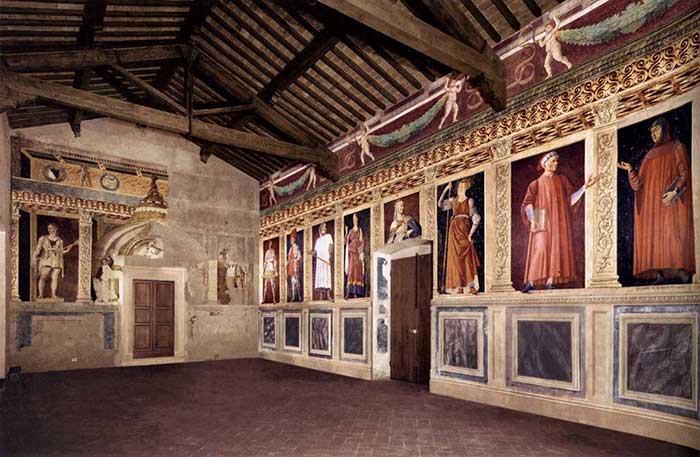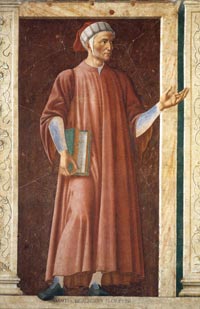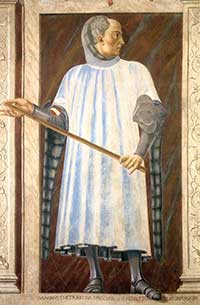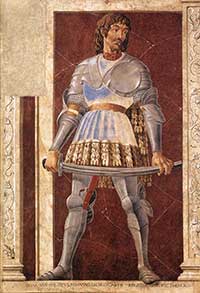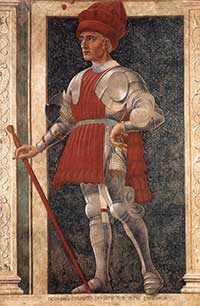Andrea del Castagno | Famous Persons |
In these severe and monumental figures, clearly based on the models provided by Masaccio and Donatello, Andrea del Castagno gives us an exaltation of mankind seen as possessing physical strength, moral virtues and a keen intelligence: the qualities of Renaissance man. In this series of portrayal, he comes across as the spokesman for the fundamental principles of Humanism.[1]
|
||
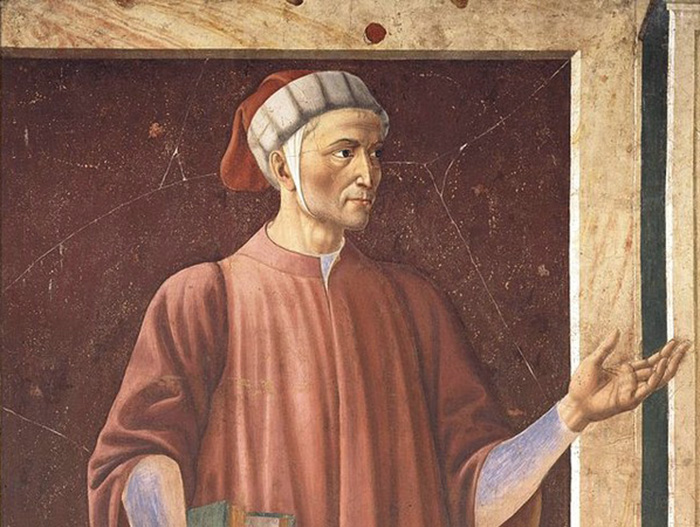 |
||
Andrea del Castagno, Dante Alighieri
|
||
| Andrea del Castagno (or Andrea di Bartolo di Bargilla) (c. 1421–1457) was an Italian painter from Florence, influenced chiefly by Tommaso Masaccio and Giotto di Bondone. His works include frescoes in Sant'Apollonia in Florence and the painted equestrian monument of Niccolò da Tolentino (1456) in the Cathedral in Florence. Little is known about his formation, though it has been hypothised that he apprenticed under Fra Filippo Lippi and Paolo Uccello. One of his earliest works depicts those hung after the Battle of Anghiari of the Florentine war with Milan. Castagno painted this after returning home to Castagno, outside Florence after the war around 1440, and the work appears on the façade of the Palazzo del Podestá. In 1447 he worked in the refectory of Sant'Apollonia in Florence, painting, in the lower part, Last Supper fresco, [2] accompanied by other scenes portraying the Deposition, Resurrection, [3] and Crucifixion, which are now damaged. In 1449-1450 he painted the Assumption with Saints Julian and Miniato for the church of San Miniato fra le Torri (now in Berlin). In the same years he collaborated with Filippo Carducci to the series of Illustrious People for the Villa Carducci at Legnaia. Andrea del Castagno died of the plague in Florence on Aug. 19, 1457. |
|
|
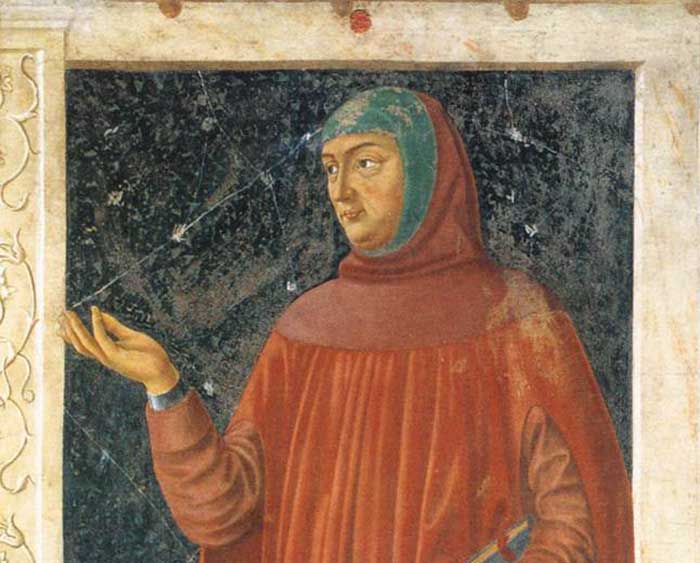 |
||
|
||
| Francesco Petrarca (1304 – 1374), commonly anglicized as Petrarch, was an Italian scholar and poet in Renaissance Italy, and one of the earliest humanists. Petrarch's rediscovery of Cicero's letters is often credited for initiating the 14th-century Renaissance. In the 16th century, Pietro Bembo created the model for the modern Italian language based on Petrarch's works, as well as those of Giovanni Boccaccio, and, to a lesser extent, Dante Alighieri.[3] Petrarch would be later endorsed as a model for Italian style by the Accademia della Crusca. Petrarch's sonnets were admired and imitated throughout Europe during the Renaissance and became a model for lyrical poetry. He is also known for being the first to develop the concept of the "Dark Ages".[4] Petrarch was born Francesco Petrarca on July 20, 1304, in Arezzo, Tuscany. He was a devoted classical scholar who is considered the "Father of Humanism," a philosophy that helped spark the Renaissance. Petrarch's writing includes well-known odes to Laura, his idealized love. His writing was also used to shape the modern Italian language. Petrarch is best known for his Italian poetry, notably the Canzoniere ("Songbook") and the Trionfi ("Triumphs"). Influenced by his interest in the classics, many of Petrarch’s poems are highly allegorical and constructed using Italian forms such as terza rima, ballate, sestine and canzoni. His poems investigate the connection between love and chastity in the foreground of a political landscape, though many of them are also driven by emotion and sentimentality. Critic Robert Stanley Martin writes that Petrarch “reimagined the conventions of love poetry in the most profound way: love for the idealized lady was the path towards learning how to properly love God . . . His work has a grace that, among his predecessors, is second only to Dante’s, and it often shows a greater refinement, particularly in its development of conceits. Petrarch will often begin with a single trope and develop it into a conceit that defines the entire sonnet.” He died at age 69 on July 18 or 19, 1374, in Arquà, Carrara.
|
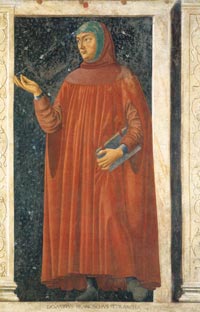 |
|
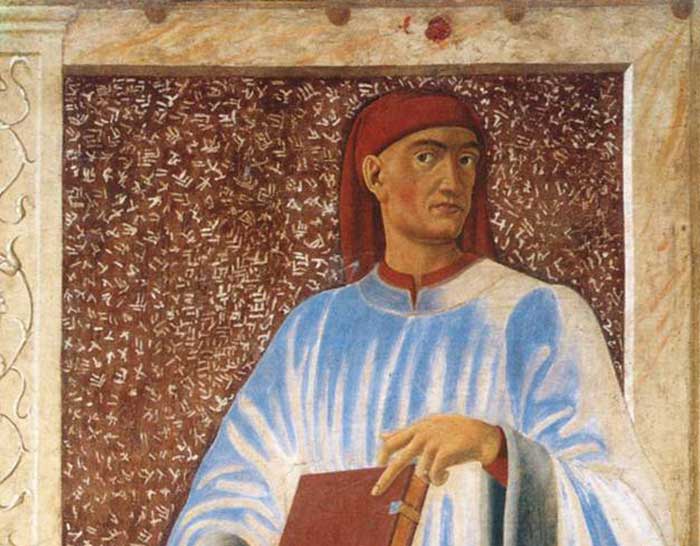 |
||
|
||
| The picture depicts Boccaccio, one of the three Tuscan poets represented in the cycle. Giovanni Boccaccio (1313-1375), was an Italian poet and scholar, best remembered as the author of the earthy tales in the Decameron. With Petrarch he laid the foundations for the humanism of the Renaissance and raised vernacular literature to the level and status of the classics of antiquity. Boccaccio wrote a number of notable works, including the Decameron and On Famous Women. As a poet who wrote in the Italian vernacular, Boccaccio is particularly noted for his realistic dialogue, which differed from that of his contemporaries, medieval writers who usually followed formulaic models for character and plot. Boccaccio grew up in Florence. His father worked for the Compagnia dei Bardi and in the 1320s married Margherita dei Mardoli, of well-to-do family. His father introduced him to the Neapolitan nobility and the French-influenced court of Robert the Wise (the king of Naples) in the 1330s. At this time he fell in love with a married daughter of the king, who is portrayed as "Fiammetta" in many of Boccaccio's prose romances, including Il Filocolo (1338). Boccaccio became a friend of fellow Florentine Niccolò Acciaioli, and benefited from his influence as the administrator, and perhaps the lover, of Catherine of Valois-Courtenay, widow of Philip I of Taranto. Acciaioli later became counselor to Queen Joan I of Naples and, eventually, her Grand Seneschal. In Naples, Boccaccio began what he considered his true vocation, poetry. Works produced in this period include Filostrato and Teseida (the sources for Chaucer's Troilus and Criseyde and The Knight's Tale, respectively), Filocolo, a prose version of an existing French romance, and La caccia di Diana, a poem in terza rima listing Neapolitan women.[7] The period featured considerable formal innovation, including possibly the introduction of the Sicilian octave to Florence, where it influenced Petrarch. Boccaccio began work on the Decameron[9][10] around 1349. It is probable that the structures of many of the tales date from earlier in his career, but the choice of a hundred tales and the frame-story lieta brigata of three men and seven women dates from this time. The work was largely complete by 1352. It was Boccaccio's final effort in literature and one of his last works in Italian; the only other substantial work was Corbaccio (dated to either 1355 or 1365). Boccaccio revised and rewrote the Decameron in 1370–1371. This manuscript has survived to the present day. In 1360, Boccaccio began work on De mulieribus claris, a book offering biographies of one hundred and six famous women, that he completed in 1374. Following the failed coup of 1361, a number of Boccaccio's close friends and other acquaintances were executed or exiled in the subsequent purge. Although not directly linked to the conspiracy, it was in this year that Boccaccio left Florence to reside in Certaldo, and became less involved in government affairs. He did not undertake further missions for Florence until 1365, and traveled to Naples and then on to Padua and Venice, where he met up with Petrarch in grand style at Palazzo Molina, Petrarch's residence as well as the place of Petrarch's library. He later returned to Certaldo. He met Petrarch only once again, in Padua in 1368. Upon hearing of the death of Petrarch (19 July 1374), Boccaccio wrote a commemorative poem, including it in his collection of lyric poems, the Rime. Boccaccio's change in writing style in the 1350s was not due just to meeting with Petrarch. It was mostly due to poor health and a premature weakening of his physical strength. It also was due to disappointments in love. Some such disappointment could explain why Boccaccio, having previously written always in praise of women and love, came suddenly to write in a bitter Corbaccio style. Petrarch describes how Pietro Petrone (a Carthusian monk) on his death bed in 1362 sent another Carthusian (Gioacchino Ciani) to urge him to renounce his worldly studies.[16] Petrarch then dissuaded Boccaccio from burning his own works and selling off his personal library, letters, books, and manuscripts. Petrarch even offered to purchase Boccaccio's library, so that it would become part of Petrarch's library. However, upon Boccaccio's death his entire collection was given to the monastery of Santo Spirito, in Florence, where it still resides.[17] His final years were troubled by illnesses, some relating to obesity and what often is described as dropsy, severe edema that would be described today as congestive heart failure. He died at the age of sixty-two on 21 December 1375 in Certaldo, where he is buried.
|
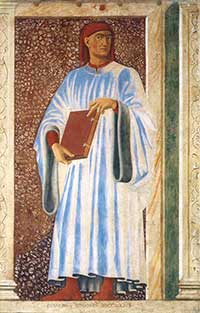 |
|
| The picture shows one of the three famous women represented in the cycle.
Esther, the beautiful Jewish wife of the Persian king Ahasuerus (Xerxes I), and her cousin Mordecai persuaded the king to retract an order for the general annihilation of Jews throughout the empire. The massacre had been plotted by the king's chief minister, Haman, and the date decided by casting lots (purim). Instead, Haman was hanged on the gallows he built for Mordecai; and on the day planned for their annihilation, the Jews destroyed their enemies. |
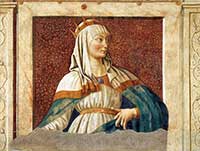 Famous Persons: Queen Esther, c. 1450, fresco transferred to wood, 120 x 150 cm, Galleria degli Uffizi, Florence |
|
|
||
| The Cumaean Sibyl is one of the three famous women represented in the cycle. The Cumaean Sibyl, wrapped in a wide red cloak with metallic highlights on the folds, also represents the same heroic ideals as the commanders. The severity of her face, which is both beautiful and dignified, together with her raised right hand, is the sign of the gravity of her prophecies. A famous collection of sibylline prophecies, the Sibylline Books, was traditionally offered for sale to Tarquinius Superbus, the last of the seven kings of Rome, by the Cumaean sibyl. He refused to pay her price, so the sibyl burned six of the books before finally selling him the remaining three at the price she had originally asked for all nine. The books were thereafter kept in the temple of Jupiter on the Capitoline Hill, to be consulted only in emergencies. The Cumaean Sibyl was the priestess presiding over the Apollonian oracle at Cumae, a Greek colony located near Naples, Italy. The word sibyl comes (via Latin) from the ancient Greek word sibylla, meaning prophetess. There were many sibyls in different locations throughout the ancient world. The importance of the Cumaean Sibyl in the legends of early Rome as codified in Virgil's Aeneid VI, the Cumaean Sibyl became the most famous among the Romans, because she was near to Roma. The Erythraean Sibyl from modern-day Turkey was famed among Greeks, as was the oldest Hellenic oracle, Sibyl of Dodona, possibly dating to the second millennium BC according to Herodotus favored in the east. The Cumaean Sibyl is one of the four sibyls painted by Raphael at Santa Maria della Pace (see gallery below.) She was also painted by Andrea del Castagno (Uffizi Gallery, illustration right), and in the Sistine Ceiling of Michelangelo her powerful presence overshadows every other sibyl, even her younger and more beautiful sisters, such as the Delphic Sibyl. There are various names for the Cumaean Sibyl besides the "Herophile" of Pausanias and Lactantius[5] or the Aeneid's "Deiphobe, daughter of Glaucus": "Amaltheia", "Demophile" or "Taraxandra" are all offered in various references.
|
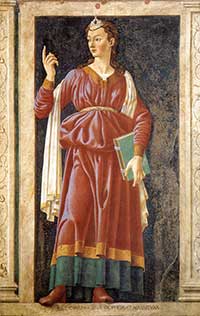 |
|
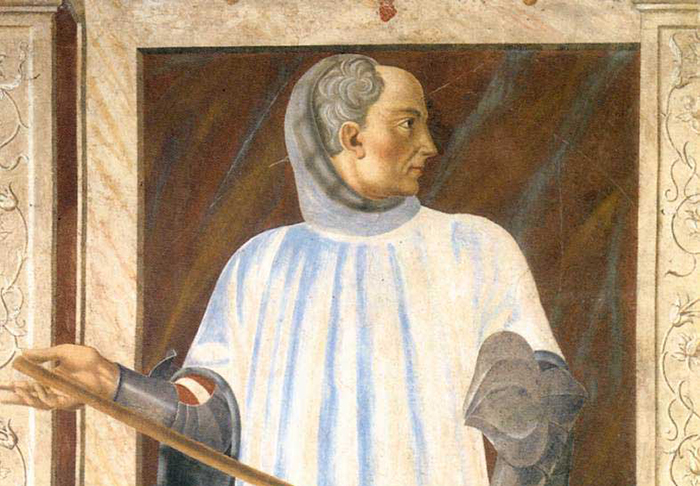 |
||
Niccolò was statesman, soldier, and grand seneschal of Naples who enjoyed a predominant position in the Neapolitan court. He led the conquest of almost all of Sicily (1356-57).
|
||
| The picture shows Niccolò Acciaioli, one of the three Florentine military commanders represented in the cycle. Niccolò Acciaioli (1310-1365) was an Italian noble, a member of the Florentine banking family of the Acciaioli. He was the grand seneschal of the Kingdom of Naples and count of Melfi, Malta, and Gozo in the mid-fourteenth century. Of a prominent and wealthy Florentine family, Acciaiuoli went to Naples in 1331 to direct the family’s banking interests. In 1335 King Robert made him a knight, entrusted him with the care of his nephew Louis of Taranto, and bestowed upon him a series of fiefs in Apulia and in Greece. He was a friend of writers and humanists , including Petrarch and Boccaccio. |
|
|
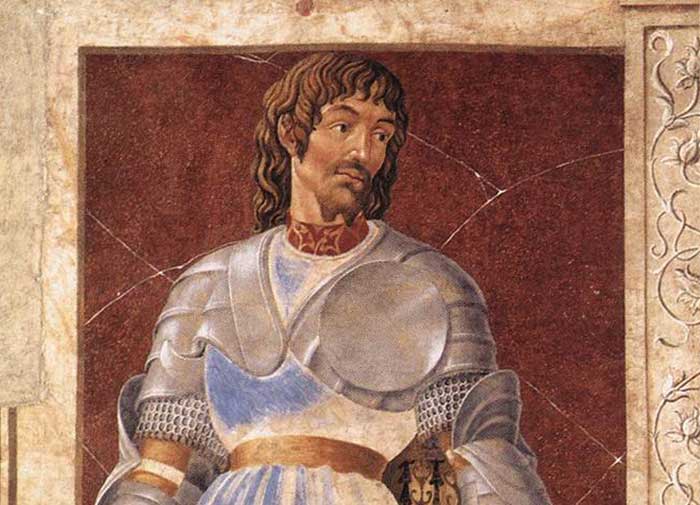 |
||
|
||
| The picture shows Pippo Spano, one of the three Florentine military commanders represented in the cycle. One of the most successful portrayals is the figure of Pippo Spano, a famous Florentine conottiero (who died in Hungary in 1426), seen as the ideal hero. The masterful draughtsmanship and the perceptive description of the character, shown in a natural pose, confirm the opinion Vasari expressed of Andrea's work: "He was extremely talented at portraying figures in solemn poses and in making them awesome, both men and women, with fierce expressions created thanks to his excellent draughtsmanship." |
|
|
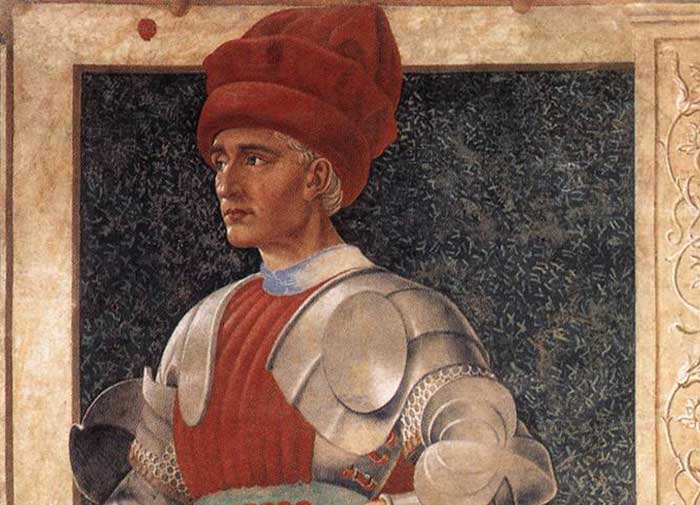 |
||
Andrea del Castagno, Famous Persons: Farinata degli Uberti, c. 1450, fresco transferred to wood, 250 x 154 cm, Galleria degli Uffizi, Florence
|
||
| The picture shows one of the three Florentine military commanders represented in the cycle, Farinata degli Uberti. Farinata degli Uberti (... – November 11, 1264), real name Manente degli Uberti,[1] was an Italian aristocrat and military leader, considered by some of his contemporaries to be a heretic. He is remembered mostly for his appearance in Dante Alighieri's Inferno and is mentioned in C.S. Lewis's short "sequel" to The Screwtape Letters, Screwtape Proposes a Toast. Farinata degli Uberti was a Florentine nobleman who became the leader of the Florentine Ghibellines, the proimperial party. According to Dante, Uberti alone dissuaded the members of the Ghibelline coalition from razing the city of Florence, which they had just captured. Life Heresy |
||
Farinata died at Florence in 1264. In 1283 his body and his wife's, Adaleta, were exhumed from their resting place in Santa Reparata; and subsequently tried for heresy. They were proven guilty by the Franciscan-led inquisition; their remains faced a posthumous execution. According to Boccaccio, in his commentary on Dante, the inquisition discovered, among other things, that Farinata denied life after death:
|
||
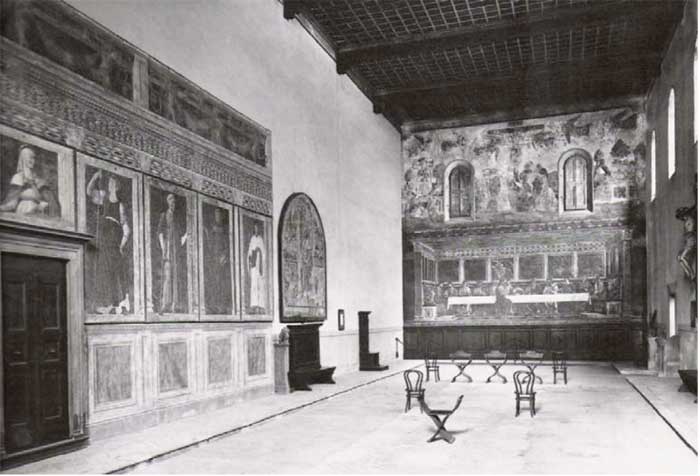 |
||
|
Cenacolo of Sant’Apollonia with the Famous Men and Women by Andrea del Castagno, photograph from the beginning of the nineteenth century, when the fresco cycle was transferred to Sant'Apollonia, Florence
|
||
[1] Source: www.wga.hu
|
||||
| This article uses material from the Wikipedia articles Petrarch, Cumaean Sibyl, published under the GNU Free Documentation License. |
||||
Art in Tuscany | Italian Renaissance painting Art in Tuscany | Giorgio Vasari | Lives of the Most Excellent Painters, Sculptors, and Architects | Andrea del Castagno Giorgio Vasari | Le vite de' più eccellenti architetti, pittori, et scultori italiani, da Cimabue insino a' tempi nostri | Andrea da 'l Castagno di Mugello Martin Kemp and Antonio Criminisi, Paolo Uccello’s “Rout of San Romano”: Order from Chaos |www.bigbridge.org(pdf) |
||||
The contemporary art selection of the owners is unusual but superb. Holiday homes in the Tuscan Maremma | Podere Santa Pia |
||||
 |
||||
Podere Santa Pia |
Podere Santa Pia, southern terrace |
Florence, Duomo Santa Maria del Fiore
|
||
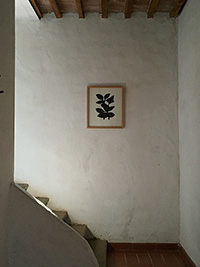 |
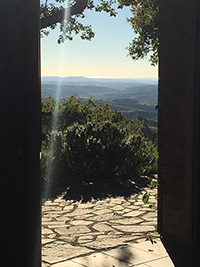 |
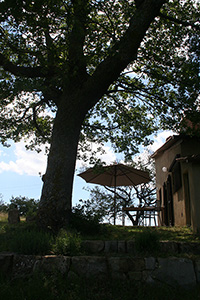 |
||
|
||||
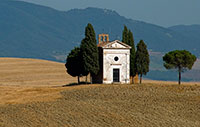 |
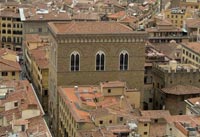 |
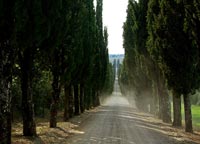 |
||
| San Quirico d'Orcia, Capella Vitaleta | Florence, Orsanmichele |
Villa Arceno gardens |
||
|
||||

